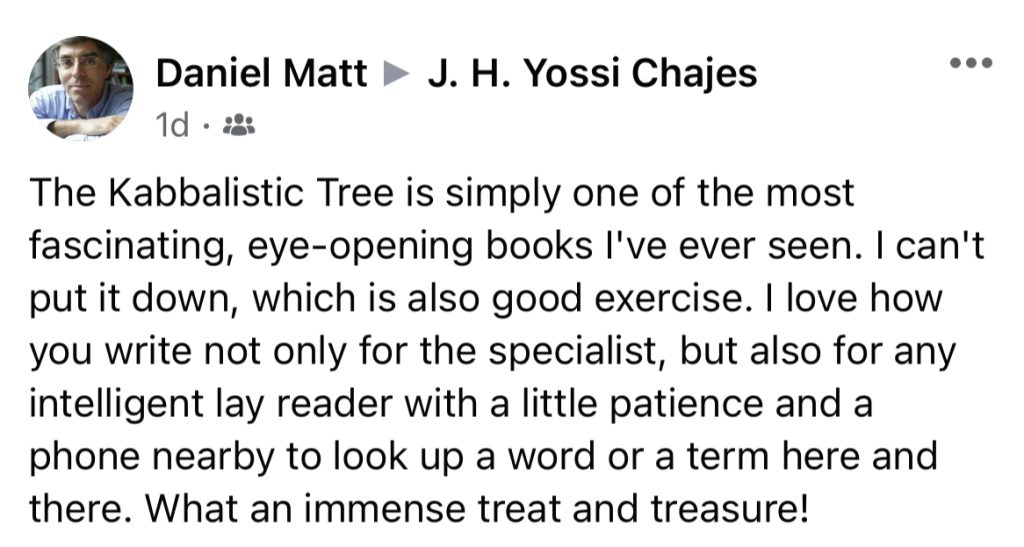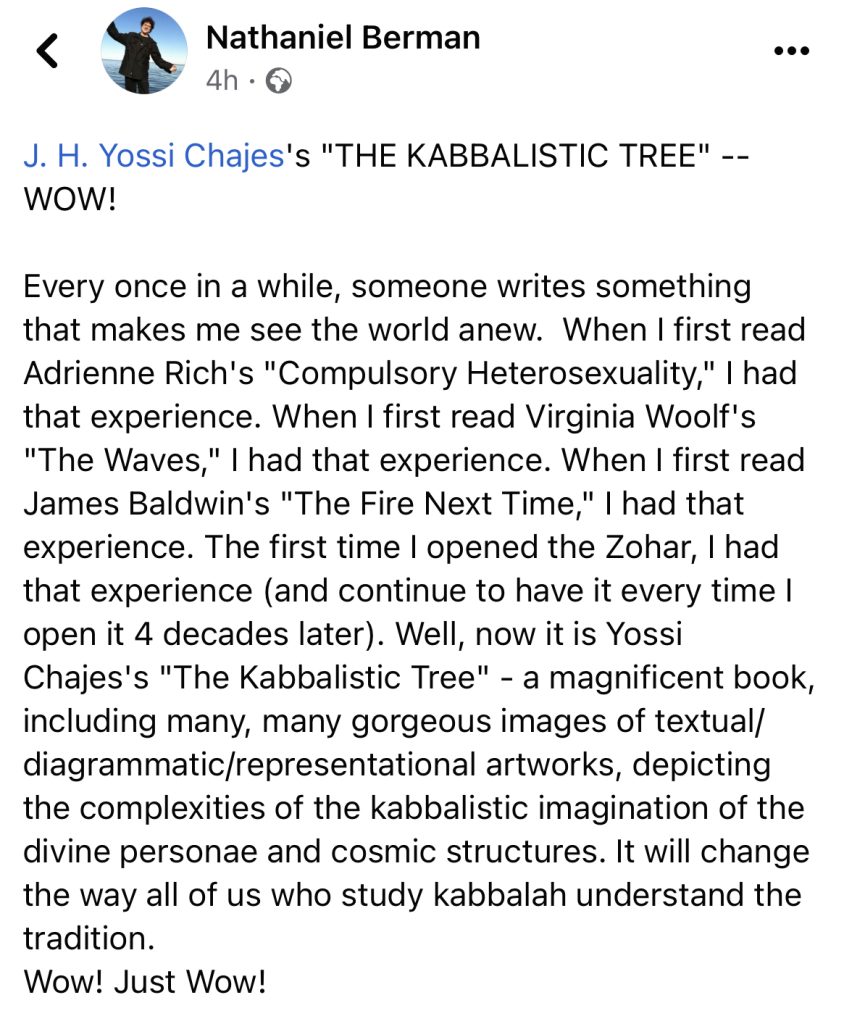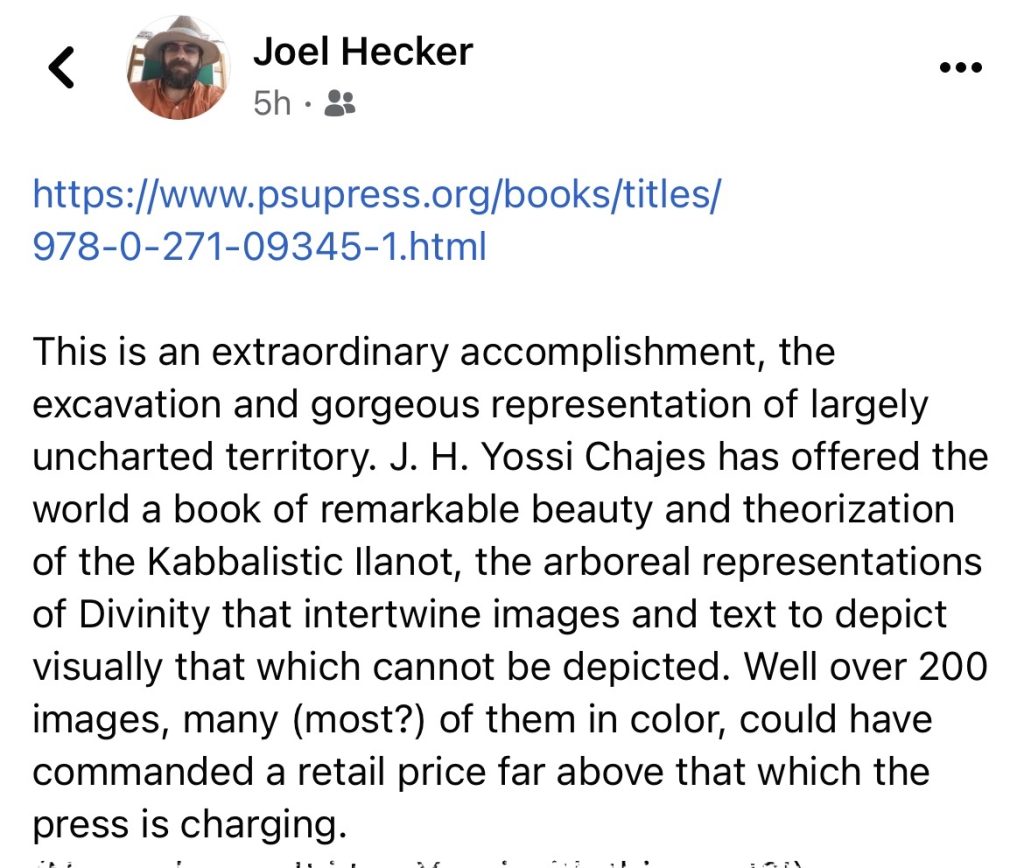
For 30% off The Kabbalistic Tree, use coupon code ILANOT on any order placed on the publisher’s website:
https://www.psupress.org/books/titles/978-0-271-09345-1.html
First Reviews and Responses to The Kabbalistic Tree
“A monumental achievement that will be valuable to scholars and general readers interested in Judaism, religion, and art history.” Library Journal – Starred Advance Review
Video Review of The Kabbalistic Tree – ESOTERIC BOOK REVIEW

The Kabbalistic Tree is simply one of the most fascinating, eye-opening books I’ve ever seen. I can’t put it down, which is also good exercise. I love how you write not only for the specialist, but also for any intelligent lay reader with a little patience and a phone nearby to look up a word or a term here and there. What an immense treat and treasure!

J. H. Yossi Chajes’s “THE KABBALISTIC TREE” – – WOW!
Every once in a while, someone writes something that makes me see the world anew. When I first read Adrienne Rich’s “Compulsory Heterosexuality,” I had that experience. When I first read Virginia Woolf’s “The Waves,” I had that experience. When I first read James Baldwin’s “The Fire Next Time,” I had that experience. The first time I opened the Zohar, I had that experience (and continue to have it every time I open it 4 decades later).
Well, now it is Yossi Chajes’s “The Kabbalistic Tree” – a magnificent book, including many, many gorgeous images of textual/ diagrammatic/representational artworks, depicting the complexities of the kabbalistic imagination of the divine personae and cosmic structures.
It will change the way all of us who study kabbalah understand the tradition.
Wow! Just Wow!

It’s been many years – – perhaps since Melila Hellner-Eshed’s “A River Flows from Eden” – – since I read a book on Kabbalah that is as transformative and simply jaw-dropping as J. H. Yossi Chajes’s new volume, “The Kabbalistic Tree.”
First, this is the single most beautiful scholarly volume of Kabbalah in history. Not joking, it’s the perfect Chanukah or Christmas gift for the Judaism/ Kabbalah/Qabbalah enthusiast in your life.
Second, the book demonstrates that there’s an entire genre of Kabbalistic artistic-textual production that has been almost completely ignored in scholarship: diagrammatic depictions of the Divine, written (until recently) on parchment, known as “llanot.” Trees, of course – – but more like matrices of the microcosm-macrocosm-Divine, scientific diagrams (Chajes analogizes them to Venn diagrams – I think they closely resemble circuit designs from engineering).
These documents, richly reproduced in this volume, circulated widely, but because they weren’t “books,” they didn’t get the scholarly attention of more traditional written texts. But these visual forms of knowledge and pedagogy are essential, Chajes shows, to the growth and dissemination of Kabbalah, especially Lurianic Kabbalah, which multiplied the baroque complexity of Jewish theosophy to a literally dizzying extent. Literally dizzying – one grows dizzy looking at these Ilanot.
Which for me is the third and maybe greatest revelation here: that this is a distinct form of mystical/ spiritual consciousness. Not, as Chajes notes, “mystical” in the sense of vague quasi-romantic feelings (not that there’s anything wrong with that) but in a different mode, a kind of nerdy-left-brain-ecstatic modality, like one might get from looking at the periodic table or engineering diagrams or a good data visualization or a map or other visual depictions of scientific reality and the relationships between all these component parts. There’s a distinct kind of intellectual-visual pleasure here, one that comes from contemplating Kabbalah’s esoteric secrets of the structure of the Divine (“ma’arechet ha’elohut”).
As Chajes writes, “Kabbalah has many secrets but little mystery.” Sinews, bones, pipes, channels, structures — these, not unitive experiences — are the stuff of this esoteric consciousness.
This experiential aspect is not the primary focus of “The Kabbalistic Tree,” though it is discussed somewhat. But I found it emerged for me in the contemplation of the book itself. Just as Hellner-Eshed transformed our understanding of the mystical experience of the Zohar, so “The Kabbalistic Tree” transforms our understanding of the ‘mystical’ experience of the contemplation of these diagrams of the Divine. As Boaz Huss has pointed out, the term ‘mystical’ can be very unhelpful because it imports various Christian assumptions of what the experience is supposed to be. Here is a uniquely non-mystical mysticism that, to me, proves that point. If we insist on seeing Kabbalah as “Jewish mysticism,” we miss what is often most distinctive, weird, and fascinating about it. Is this ‘mysticism’ in the classical sense? No, it’s something much more intriguing.
Read. This. Book.

This is an extraordinary accomplishment, the excavation and gorgeous representation of largely uncharted territory. J. H. Yossi Chajes has offered the world a book of remarkable beauty and theorization of the Kabbalistic Ilanot, the arboreal representations of Divinity that intertwine images and text to depict visually that which cannot be depicted. Well over 200 images, many (most?) of them in color, could have commanded a retail price far above that which the press is charging.

Look what just arrived! J. H. Yossi Chajes’s magisterial tome about the “tree of life.” It is simply spectacular! Here is my endorsement and I mean every word: “A tour de force! A brilliant analysis of an astonishing object. Dense with texts and drawings, these Kabbalistic scrolls finally receive the scholarly attention they so deserve. In his analysis of these cosmological visualizations, Chajes treats image and text as an inseparable totality. The result is a model for the analysis of ‘iconotexts’! A richly illustrated work of great erudition and intellectual imagination and a fascinating read.”
“Chajes has made these trees of ink on parchment and paper sing out loud and clear, redeeming them from obscurity and thus simultaneously enriching the fields of the history of visual aesthetics and the history of Jewish culture.”—Marc Michael Epstein, author of Skies of Parchment, Seas of Ink: Jewish Illuminated Manuscripts
“J. H. Chajes’s spectacular book offers a comprehensive and fascinating study of the diagrammatic visualization of Kabbalistic knowledge. Chajes’s meticulous study of the arboreal Kabbalistic diagrams is an outstanding contribution to the study of Kabbalah, early modern and modern Jewish history, and Jewish visual culture.”—Boaz Huss, author of Mystifying Kabbalah: Academic Scholarship, National Theology, and New Age Spirituality
“Until this volume there has been no work that endeavours to provide scholars and laypeople with a broad overall and particular description of the ilanot in all of their varieties, twists, and turns. This enterprise is fascinating and truly illuminating, and no one to this day has touched even a fraction of what the book has to offer.”—Richard I. Cohen, co-author of Samuel Hirszenberg, 1865–1908: A Polish Jewish Artist in Turmoil
“A tour de force! A brilliant analysis of an astonishing object. Dense with texts and drawings, these Kabbalistic scrolls finally receive the scholarly attention they so deserve. In his analysis of these cosmological visualizations, Chajes treats image and text as an inseparable totality. The result is a model for the analysis of ‘iconotexts.’ A richly illustrated work of great erudition and intellectual imagination and a fascinating read.”—Barbara Kirshenblatt-Gimblett, Chief Curator of the Core Exhibition at POLIN Museum of the History of Polish Jews
“Late in the Middle Ages—mysteriously, graphically, and in a strikingly abstract, yet concrete fashion—Kabbalistic trees began sprouting from Judaism’s alphabet-saturated ground. J. H. Chajes’s magnificent study takes us for the first time into the history of their emergence andburgeoning, where visual and verbal vectors align, and the ‘double-helix of Kabbalah’ is revealed. This is a path-breaking book, years in the making and thrilling to read.”—Peter Cole, author of The Poetry of Kabbalah: Mystical Verse from the Jewish Tradition
This is a book of a lifetime!!!! A life work and a wonderful addition to Jewish life.” — Rabbi Rayzel Raphael

“Chajes’s densely illustrated historical study of the various schemas by which kabbalists mapped both cosmogony and intra-divine relationality is an outstanding work of scholarship, and written in an engaging, almost conversation tone that really animates the intellectual worlds and personalities of the people behind the diagrams.”—Brian Johnson
“Isn’t it gorgeous!”—Alexander Kaval
“Seriously the esoteric studies publication of the year, maybe decade.”—Ted Hand
“Or of this century:-)
Seriously, J. H. Yossi Chajes’ depth of scholarship and the high quality of book production sets a gold standard for any other work to aspire to.”—Avi Solomon



